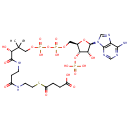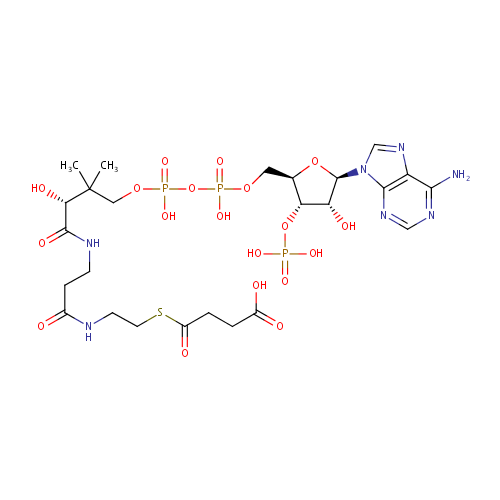
Succinyl-CoA (PAMDB000228)
| Record Information | |||||||||||||||||||||||||||||||||||||||||||||||||||||||||||||
|---|---|---|---|---|---|---|---|---|---|---|---|---|---|---|---|---|---|---|---|---|---|---|---|---|---|---|---|---|---|---|---|---|---|---|---|---|---|---|---|---|---|---|---|---|---|---|---|---|---|---|---|---|---|---|---|---|---|---|---|---|---|
| Version | 1.0 | ||||||||||||||||||||||||||||||||||||||||||||||||||||||||||||
| Update Date | 1/22/2018 11:54:54 AM | ||||||||||||||||||||||||||||||||||||||||||||||||||||||||||||
| Metabolite ID | PAMDB000228 | ||||||||||||||||||||||||||||||||||||||||||||||||||||||||||||
| Identification | |||||||||||||||||||||||||||||||||||||||||||||||||||||||||||||
| Name: | Succinyl-CoA | ||||||||||||||||||||||||||||||||||||||||||||||||||||||||||||
| Description: | Succinyl-CoA is a combination of succinic acid and coenzyme A. It is an important intermediate in the citric acid cycle, where it is synthesized from alpha-Ketoglutarate by alpha-ketoglutarate dehydrogenase through decarboxylation. During the process, coenzyme A is added. It is also synthesized from propionyl CoA, the odd-numbered fatty acid, which cannot undergo beta-oxidation. Propionyl-CoA is carboxylated to D-methylmalonyl-CoA, isomerized to L-methylmalonyl-CoA, and rearranged to yield succinyl-CoA via a vitamin B12-dependent enzyme. Succinyl-CoA is an intermediate of the citric acid cycle. | ||||||||||||||||||||||||||||||||||||||||||||||||||||||||||||
| Structure | |||||||||||||||||||||||||||||||||||||||||||||||||||||||||||||
| Synonyms: |
| ||||||||||||||||||||||||||||||||||||||||||||||||||||||||||||
| Chemical Formula: | C25H40N7O19P3S | ||||||||||||||||||||||||||||||||||||||||||||||||||||||||||||
| Average Molecular Weight: | 867.607 | ||||||||||||||||||||||||||||||||||||||||||||||||||||||||||||
| Monoisotopic Molecular Weight: | 867.131252359 | ||||||||||||||||||||||||||||||||||||||||||||||||||||||||||||
| InChI Key: | VNOYUJKHFWYWIR-FZEDXVDRSA-N | ||||||||||||||||||||||||||||||||||||||||||||||||||||||||||||
| InChI: | InChI=1S/C25H40N7O19P3S/c1-25(2,20(38)23(39)28-6-5-14(33)27-7-8-55-16(36)4-3-15(34)35)10-48-54(45,46)51-53(43,44)47-9-13-19(50-52(40,41)42)18(37)24(49-13)32-12-31-17-21(26)29-11-30-22(17)32/h11-13,18-20,24,37-38H,3-10H2,1-2H3,(H,27,33)(H,28,39)(H,34,35)(H,43,44)(H,45,46)(H2,26,29,30)(H2,40,41,42)/t13-,18-,19-,20?,24-/m1/s1 | ||||||||||||||||||||||||||||||||||||||||||||||||||||||||||||
| CAS number: | 604-98-8 | ||||||||||||||||||||||||||||||||||||||||||||||||||||||||||||
| IUPAC Name: | 4-[(2-{3-[(2R)-3-[({[({[(2R,3S,4R,5R)-5-(6-amino-9H-purin-9-yl)-4-hydroxy-3-(phosphonooxy)oxolan-2-yl]methoxy}(hydroxy)phosphoryl)oxy](hydroxy)phosphoryl}oxy)methyl]-2-hydroxy-3-methylbutanamido]propanamido}ethyl)sulfanyl]-4-oxobutanoic acid | ||||||||||||||||||||||||||||||||||||||||||||||||||||||||||||
| Traditional IUPAC Name: | succinyl-coa | ||||||||||||||||||||||||||||||||||||||||||||||||||||||||||||
| SMILES: | CC(C)(COP(O)(=O)OP(O)(=O)OC[C@H]1O[C@H]([C@H](O)[C@@H]1OP(O)(O)=O)N1C=NC2=C1N=CN=C2N)C(O)C(=O)NCCC(=O)NCCSC(=O)CCC(O)=O | ||||||||||||||||||||||||||||||||||||||||||||||||||||||||||||
| Chemical Taxonomy | |||||||||||||||||||||||||||||||||||||||||||||||||||||||||||||
| Taxonomy Description | This compound belongs to the class of organic compounds known as acyl coas. These are organic compounds containing a coenzyme A substructure linked to an acyl chain. | ||||||||||||||||||||||||||||||||||||||||||||||||||||||||||||
| Kingdom | Organic compounds | ||||||||||||||||||||||||||||||||||||||||||||||||||||||||||||
| Super Class | Lipids and lipid-like molecules | ||||||||||||||||||||||||||||||||||||||||||||||||||||||||||||
| Class | Fatty Acyls | ||||||||||||||||||||||||||||||||||||||||||||||||||||||||||||
| Sub Class | Fatty acyl thioesters | ||||||||||||||||||||||||||||||||||||||||||||||||||||||||||||
| Direct Parent | Acyl CoAs | ||||||||||||||||||||||||||||||||||||||||||||||||||||||||||||
| Alternative Parents |
| ||||||||||||||||||||||||||||||||||||||||||||||||||||||||||||
| Substituents |
| ||||||||||||||||||||||||||||||||||||||||||||||||||||||||||||
| Molecular Framework | Aromatic heteropolycyclic compounds | ||||||||||||||||||||||||||||||||||||||||||||||||||||||||||||
| External Descriptors |
| ||||||||||||||||||||||||||||||||||||||||||||||||||||||||||||
| Physical Properties | |||||||||||||||||||||||||||||||||||||||||||||||||||||||||||||
| State: | Solid | ||||||||||||||||||||||||||||||||||||||||||||||||||||||||||||
| Charge: | -5 | ||||||||||||||||||||||||||||||||||||||||||||||||||||||||||||
| Melting point: | Not Available | ||||||||||||||||||||||||||||||||||||||||||||||||||||||||||||
| Experimental Properties: |
| ||||||||||||||||||||||||||||||||||||||||||||||||||||||||||||
| Predicted Properties |
| ||||||||||||||||||||||||||||||||||||||||||||||||||||||||||||
| Biological Properties | |||||||||||||||||||||||||||||||||||||||||||||||||||||||||||||
| Cellular Locations: | Cytoplasm | ||||||||||||||||||||||||||||||||||||||||||||||||||||||||||||
| Reactions: | alpha-Ketoglutarate + Coenzyme A + NAD > Carbon dioxide + NADH + Succinyl-CoA Adenosine triphosphate + Coenzyme A + Succinic acid <> ADP + Phosphate + Succinyl-CoA Water + Succinyl-CoA + Tetrahydrodipicolinate <> Coenzyme A + N-Succinyl-2-amino-6-ketopimelate Coenzyme A + 3-Oxoadipyl-CoA <> Acetyl-CoA + Succinyl-CoA L-Arginine + Succinyl-CoA <> Coenzyme A + Hydrogen ion + N2-Succinyl-L-arginine Succinyl-CoA > (S)-Methylmalonyl-CoA Propionyl-CoA + Succinic acid > Propionic acid + Succinyl-CoA L-Homoserine + Succinyl-CoA <> Coenzyme A + O-Succinyl-L-homoserine Succinyl-CoA + L-Arginine <> Coenzyme A + N2-Succinyl-L-arginine (R)-Methylmalonyl-CoA <> Succinyl-CoA Succinyl-CoA + Enzyme N6-(dihydrolipoyl)lysine + Enzyme N6-(dihydrolipoyl)lysine <> Coenzyme A + [Dihydrolipoyllysine-residue succinyltransferase] S-succinyldihydrolipoyllysine Oxoglutaric acid + Coenzyme A + NAD > Succinyl-CoA + Carbon dioxide + NADH R-Methylmalonyl-CoA <> Succinyl-CoA Acetoacetyl-CoA + Coenzyme A + Acetoacetyl-CoA > Acetyl-CoA + Succinyl-CoA + Succinyl-CoA More...(S)-2,3,4,5-tetrahydrodipicolinate + Succinyl-CoA + Water + Succinyl-CoA > Coenzyme A + N-Succinyl-2-amino-6-ketopimelate Oxoglutaric acid + NAD + Coenzyme A > Succinyl-CoA + NADH + Hydrogen ion + Carbon dioxide + Succinyl-CoA Succinyl-CoA + Phosphate + Guanosine diphosphate + Succinyl-CoA <> Succinic acid + Coenzyme A + Guanosine triphosphate Oxoglutaric acid + NAD + Coenzyme A > NADH + Carbon dioxide + Succinyl-CoA + Succinyl-CoA Succinyl-CoA + Adenosine diphosphate + Phosphate + Succinyl-CoA + ADP > Adenosine triphosphate + Coenzyme A + Succinic acid L-Arginine + Succinyl-CoA + Succinyl-CoA > Coenzyme A + Hydrogen ion + N2-succinyl-L-arginine + N2-succinyl-L-arginine L-Homoserine + Succinyl-CoA + L-Homoserine + Succinyl-CoA > Coenzyme A + O-Succinyl-L-homoserine Succinic acid + Propionyl-CoA + Propionyl-CoA > Propionic acid + Succinyl-CoA + Succinyl-CoA Succinyl-CoA + Succinyl-CoA > Methylmalonyl-CoA Succinyl-CoA + Dihydrolipoamide + Succinyl-CoA + Dihydrolipoamide > Coenzyme A + (S)-Succinyldihydrolipoamide | ||||||||||||||||||||||||||||||||||||||||||||||||||||||||||||
| Pathways: |
| ||||||||||||||||||||||||||||||||||||||||||||||||||||||||||||
| Spectra | |||||||||||||||||||||||||||||||||||||||||||||||||||||||||||||
| Spectra: |
| ||||||||||||||||||||||||||||||||||||||||||||||||||||||||||||
| References | |||||||||||||||||||||||||||||||||||||||||||||||||||||||||||||
| References: |
| ||||||||||||||||||||||||||||||||||||||||||||||||||||||||||||
| Synthesis Reference: | Wollemann, M. Mechanism of the succinyl-coenzyme A synthesis in brain extracts. Acta Physiologica Academiae Scientiarum Hungaricae (1959), 16 153-4. | ||||||||||||||||||||||||||||||||||||||||||||||||||||||||||||
| Material Safety Data Sheet (MSDS) | Not Available | ||||||||||||||||||||||||||||||||||||||||||||||||||||||||||||
| Links | |||||||||||||||||||||||||||||||||||||||||||||||||||||||||||||
| External Links: |
| ||||||||||||||||||||||||||||||||||||||||||||||||||||||||||||

